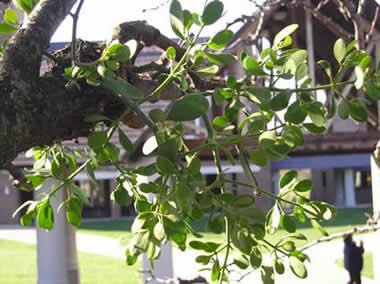
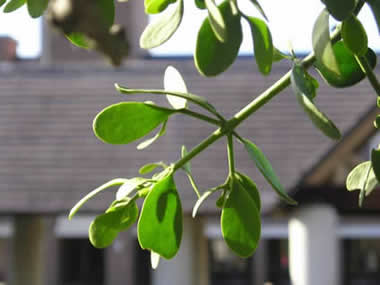
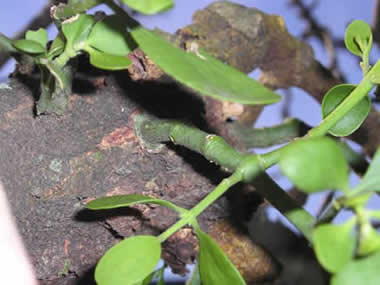
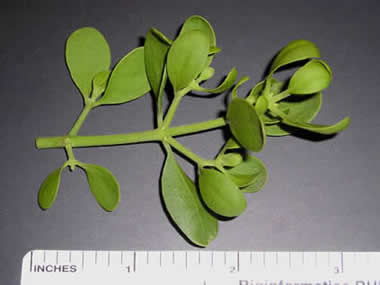
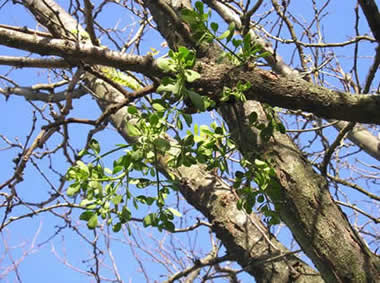
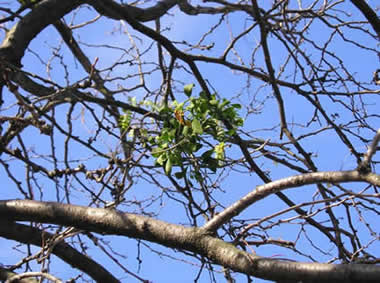
Interesting Information About Plant:
Mistletoe has an interesting story behind its name. Several hundred years ago, it was thought that the mistletoe plant was formed through the formation of bird droppings. It was thought that the plant of mistletoe could spontaneously materialize from these droppings. In ancient times, this plant would grow on twigs that already had bird droppings on it. The literal translation for the word “mistletoe” is “dung-on-a-twig.” Of course thats not true because then you'd have mistletoe growing from the hood of your car after you parked under a tree. It is actually a semi-parasitic plant, which means it needs a host to start growing and it takes nutrients and food from the host but it also makes food for itself after it starts to grow leaves. Seeds are spread in the fruit which is eaten by birds.
Mistletoe has been thought to be a very sacred plant in the countries of Europe. It is considered an aphrodisiac, as well as a protection against poison. It is considered to be one of Europe’s most sacred, magical, and mysterious plants. The Celtic Druids considered it especially sacred. On the sixth night of the moon, the Druid priests would cut the mistletoe plant off of the branches with a golden sickle. Then, two bulls would be sacrificed, and prayers would be made for the recipients of the plant. The plant of mistletoe has also been hung to keep away evil spirits.
Common Name(s): Mistletoe
Scientific Name: Phoradendron serotinum (Raf.) M.C. Johnst.
Family Name (Scientific and Common): Viscaceae (Loranthaceae), Mistletoe Family
Continent of Origin: eastern U.S.
Plant Growth Habit: Parasitic Evergreen Plant
Height at Maturity: Between 1- 3 Feet
Life Span: Perennial
Seasonal Habit: Evergreen Perennial
Growth Habitat: Partial Sun
Manner of Culture: Native Parasite (Weedy)
Thorns on Younger Stem No
Cross Section of Younger Stem: Roundish
Stem (or Trunk) Diameter: Between The Diameter of a Pencil and a Broom-Handle
Produces Brownish Bark: No
Bark Peeling in Many Areas: No
Characteristics of Mature (Brownish) Bark: Stays green whole life
Type of Leaf: Thick, Fleshy Leaf
Size of Leaf (or Leaflet): Smaller than a Credit Card
Leaf Complexity: Simple
Edge of Leaf: Smooth
Leaf Arrangement: Opposite
Leaf has Petiole: Yes
Patterns of Main-Veins on Leaf (or Leaflet): Pinnate
Leaf Hairiness: Somewhat Hairy
Color of Foliage in Summer: Green
Change in Color of Foliage in October: No Change
Flowering Season: Spring
Flowers: in Loose Group
Type of Flower: Colorful Flower
Color of Flower: Yellow
Shape of Individual Flower: Radially Symmetrical
Size of Individual Flower: Smaller than a Quarter
Sexuality: Male and Female Flowers on Separate plants
Size of Fruit: Smaller than a Quarter
Fruit Fleshiness: Fleshy
Shape of Fruit: Spherical
Color of Fruit at Maturity: White
Fruit Desirable to Birds or Squirrels: Yes
Louisville Plants That Are Most Easily Confused With This One: Nothing really (probably whatever host it is on)
Unique Morphological Features of Plant: The berry gets placed on a branch of a tree and it forms an attachment (called a haustoria) which grows into the vascular part of the plant where it steals nutrients, food, and water to start growing. Then it starts to make most of its own food (by photosynthesis) when it grows leaves.
Poisonous: Berries
Pestiness (weedy, hard to control): Yes
Page prepared by: Jon Obert and Caitlin Jones
November 24, 2004